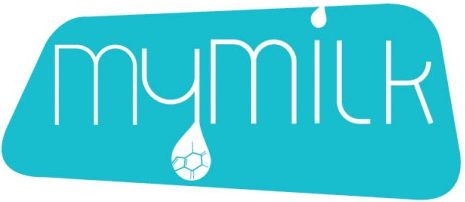Mylee
SCIENCE
WE INVENT IT FOR YOU
Backed by SCIENCE. Based on DATA
Mylee science now published in a leading peer-reviewed journal
Haramati S, Firsow A, Navarro DA, Shechter R
Novel At-Home Mother’s Milk Conductivity Sensing Technology as an Identification System of Delay in Milk Secretory Activation Progress and Early Breastfeeding Problems: Feasibility Assessment
JMIR Pediatr Parent 2023;6:e43837
WHAT IS BREASTFEEDING ESTABLISHMENT?
Breastfeeding establishment is a complex physiological process, affected by maternal physiological and behavioral process.
During this period milk composition changes as milk progress from colostrum to mature milk. This process normally takes about 3-4 weeks to be fully accomplished, with fast dynamics in the first few days, when each day is very important for milk supply establishment.
This process reflects on the efficiency and dynamic of the lactogenesis process. Identifying any delay early can help better manage any specific case, and as early the management and correction, the better are the chances for improved breastfeeding and milk supply establishment.
The better breastfeeding and milk supply is established in these first hours-days-weeks the better are the chances for good milk supply and successful exclusive breastfeeding – long term.
THE PROBLEM: Only 20% of mothers stand with health authorities recommendations of exclusive breastfeeding for the first 6 months of a baby’s life and continued breastfeeding beyond the 1st/2nd years of life, while gradually introducing solid foods. The main reason (57%) that mothers report to stop breastfeeding sooner than intended is low milk supply. Improper breastfeeding establishment is a very significant contributor to low, or any level of insufficient milk supply or intake.
The Mylee is utilizing the dynamics and rate of MILK maturation, as a reflection to this breastfeeding establishment process. By looking at the milk itself, the Mylee can help identify early trends within this dynamic process, in real time, from the first days after birth.
Haramati S, Novel At-Home Mother’s Milk Conductivity Sensing Technology as an Identification System of Delay in Milk Secretory Activation Progress and Early Breastfeeding Problems: Feasibility Assessment. JMIR Pediatr Parent 2023
CDC, Breastfeeding report card, 2020.
World Health Organization. The optimal duration of exclusive breastfeeding: report of an expert consultation, 2011
Odom EC et al. Reasons for earlier than desired cessation of breastfeeding. Pediatrics. 2013 Mar;131(3)
Brownell, Does Delayed Onset Lactogenesis II Predict the Cessation of Any or Exclusive Breastfeeding? J Pediatr. 2012
Chapman DJ, Perez-Escamilla R. Does delayed perception of the onset of lactation shorten breastfeeding duration? J Hum Lact 1999.
Dewey KG. Risk factors for suboptimal infant breastfeeding behavior, delayed onset of lactation, and excess neonatal weight loss. Pediatrics 2003
Hurst NM J Midwifery Women Health. 2007
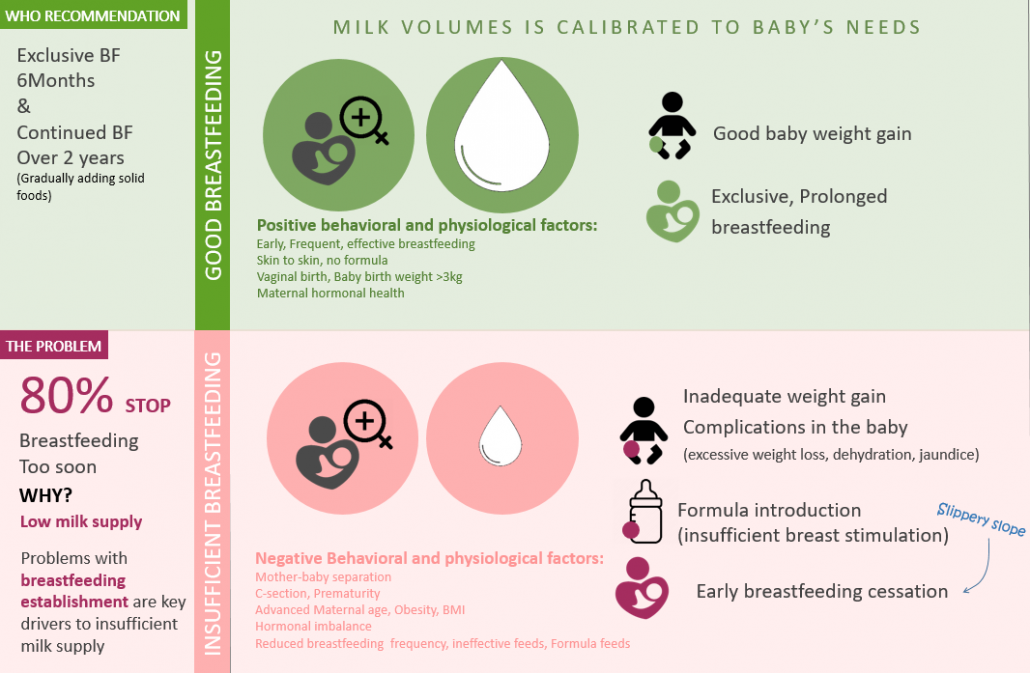
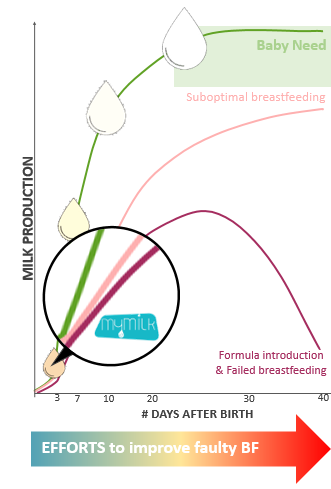
HOW IS MILK MATURATION % COMPUTED?
Milk maturation indicator was developed by MyMilk professional team to reflect breastfeeding establishment dynamics. It does NOT measure milk “quality” or sufficiency, but serves as a non-invasive “objective” biomarker reflecting the process.
This measurement cannot diagnose adequacy or inadequacy of baby feeding, although it was found to generally correlate with exclusive breastfed baby weight gain and with breastfeeding exclusivity, short and long term.
The maturation parameter is depicted as 5%-100% range that was found by our researchers to reflect the dynamics from initial colostrum (5%) to what we call “fully mature milk” (100% and beyond).
Milk maturation % is computed by measuring the electrical resistance of individual milk samples, and computing a % by placing it on the range determined by in-house generated dataset, from thousands of milk samples throughout the first 6 months of breastfeeding.
The milk maturation index is colored to reflect a day-specific-status compared to MyMilk reference dataset.
For each day after birth, the color of the index indicates whether the sample is above (green) or below (orange), the significant majority of samples from other mothers in predominant breastfeeding in comparable day range, scanned by MyMilk systems. The more advanced the greener.
Each breast can undergo maturation in different kinetics. Milk maturation % is compared between breasts, and between following scans of the same breast are computed to generate breast imbalance insights and personal goals.
These insights can also indicate possible restricted milk flow. When restricted milk flow is left unmanaged may progress to breast inflammation. This indication is not intended and cannot serve to diagnose any medical condition in the breast. But can serve as early indication for a need for improved milk removal.
For the most advanced scan of each day, the system computes the day or day-range after birth the sample corresponds to (“behaves like”), when compared to samples from other mothers in predominant breastfeeding in MyMilk sample data-set, for that time frame after birth. Comparing this to the actual time after birth can suggest whether the sample is delayed, similar, or advanced compared to MyMilk population base.

Mylee
See how the Mylee feedback and insights helps Navigate breastfeeding, informatively
Follow milk supply establishment in real-time, Detect differences between breasts, Get early reassurance cues of breastfeeding adequacy, or early indications for potential problems when needed.
DATA POWERED.
DEVELOPED BY PROFFESSIONALS. TESTED BY LACTATION CONSULTANTS. DRIVEN BY USERS.
IN-LAB TESTING at MyMilk LABS
System components, device, software, algorithm and database, were assembled, developed and verified – step by step in-house, based on thousands of milk samples, to facilitate computing individual Milk maturation indication and insights.
System was tested in MyMilk Laboratories for performance, this includes:
- Testing for sensor accuracy, precision and usability, and stability.
- Correlation to lab-grade breast milk conductivity measurement (described in the scientific literature to reflect breastfeeding status)
- Human milk Dataset was created based on in-house milk samples bio-bank, at various intervals after birth from (day 1-150). Milk data was classified based on lactation consultant or maternal provided breastfeeding information. Day-specific-References were set based on the database, for predominant breastfeeding for enabling the user to understand how her milk sample behave relative to other mothers’ samples scanned with the system.
- Milk maturation indicator was found to correlate with time after birth, and be affected by delayed lactogenesis II and by conditions of breast inflammation.
- Milk maturation indicator was inversely correlated with breastmilk sodium, a referenced indicator for delayed lactogenesis and breast inflammation.
BETA-TESTED BY LACTATION CONSULTANTS
a group of independent lactation consultants used the system with over 600 mothers for scanning milk samples, on the spot, and get immediate feedback on milk maturation
Data was collected from real world lactation consultant using the system in routine visits. System performance was compared to breastfeeding problems status as collected by lactation consultant during the session or in follow-up. System color indication was compared to lactation consultant report of breastfeeding establishment difficulties as observed in face-to-face lactation consultant direct evaluation, and maternal report regarding pain and feeding practices. System performance was comparable to breastfeeding establishment difficulties as reported by the lactation professional.
Lactation consultants have used MyLee for testing over 600 mothers on-the-spot, reported the system to be useful and valuable for their practice.
REAL WORLD BETA – DIRECTLY WITH BREASTFEEDING MOTHERS
Daily Reference values are validated and improved based on real world data gathered with the system by users. Either mothers or lactation consultants. We improve it constantly, to improve our value to any mother.
Thousands of datapoints already accumulated, and allow us to validate and optimized our algorithm, and to test our system performance.
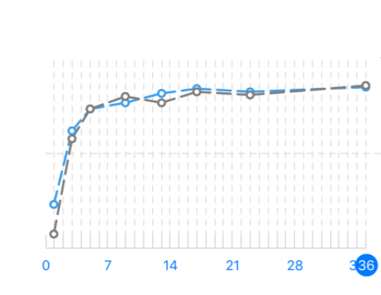
INDEVIDUAL MILK MATURATION DYNAMIC
Milk maturation % to age chart, of a single mother, each breast tracked seperatly.
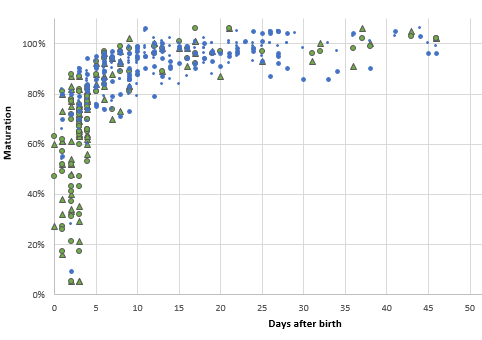
POPULATION MATURATION TO AGE
Milk maturation % to age chart for predominant breastfeeding mothers, with no reported problems, set by MyMilk Database
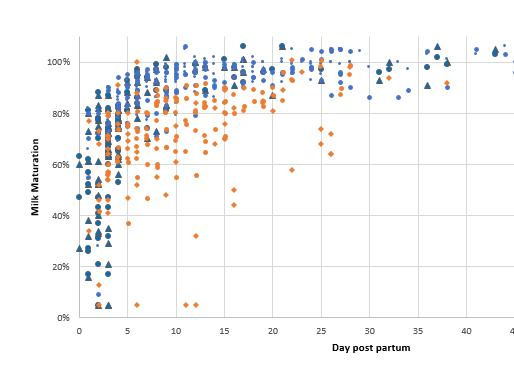
MILK MATURATION % IN POPULATION GROUPS
Milk maturation %, per day distribution, accross group populations, group based on feeding types and BF problems.
BACKED BY SCEINCE
Markers of breastfeeding and milk supply establishment, have been reported in scientific literature starting as early as the 1950s. We bring it to the hands of mothers.
Research has identified several biomarkers in human milk with certain dynamics, including sodium, glucose, citrate, protein, chloride, magnesium and more, as indicative of the transition to lactogenesis II in human milk production, when milk changes from colostrum to mature milk (Neville 1991, Kulski JK 1981, Miller&Jackson, 1951).
Milk conductivity and milk electrolytes (Na, Cl), were shown as a research tool and suggested to serve for identification of delayed lactogenesis II and the severity of delay, and as an objective early measure for successful vs. faulty breastfeeding. The extreme the value, and for the longer duration, the increased risk for milk production and breastfeeding difficulties. Normal biomarker dynamics was found to have high correlation with normal infant weight gain, future abundance of milk, and increased chances of prolonged exclusive breastfeeding. (Miller&Jackson, 1951, Morton 1994).
Breastfeeding at a high frequency or breast stimulation and emptiness by pumping and hand expression leads to improved marker dynamics and better milk production at 2 weeks and 6 weeks after birth (Galipeau, 2012, Neville& Morton J nutr 2001).
“Even though the measurement of LS-II markers is precluded from the clinical practice, its significance is of importance for healthcare professionals”. (Galipeau, 2012). “Breast milk assessment can be used to determine: (1) the adequacy of lactation and the effectiveness of suckling at a time when nursing problems may not be clinically apparent, but are more amenable to manage. (2) the optimal timing for a follow-up visit (3) the progress of women with initially elevated BM marker (4) the cause of inadequate lactation”. (Morton JA, Pediatrics, 1994)
Humenick, Breast-milk sodium as a predictor of breastfeeding patterns. Can J Nurs Res. 1998.
Galipeau R., et al. Infant and Maternal Factors Influencing Breastmilk Sodium Among Primiparous Mothers. Breastfeeding medicine, 2012, Volume 7, Number 4
Koo WW, Gupta JM. Breast milk sodium. Arch Dis Child.1982. 57(7): 500–502
Kulski JK et al. CHANGES IN HUMAN MILK COMPOSITION DURING THE INITIATION OF LACTATION. Australian Journal of Experimental Biology and Medical Science. Volume 59, Issue 1
Miller. Electrical conductivity and chloride content of women’s milk. Part 3. Relationship to adequacy of lactation, Archives of Disease in Childhood , 1951, 26(128):325-9
Miller and Jackson, Electrical conductivity and chloride content of women’s milk. Part 4. Results and their relationship to milk yield and to duration of lactation, Archives of Disease in Childhood, 1951, 26(128):329-334
Morton J et al. The Clinical Usefulness of Breast Milk Sodium in the Assessment of Lactogenesis, Pediatrics, 1994
Neville et al. , Studies in human lactation: milk volume and nutrient composition during weaning and lactogenesis. The American Journal of Clinical Nutrition, 1991;54
System cannot diagnose or treat any medical condition, nor the adequacy or inadequacy of baby feeding, and it does not substitute direct breastfeeding evaluation by a caregiver.
These reports are not intended to tell you anything about your or your baby’s current state of health, or to be used to make medical decisions. Our insight can help you monitor and manage your breastfeeding care. It is highly advised to use Mylee App while in close contact with your lactation consultant.
